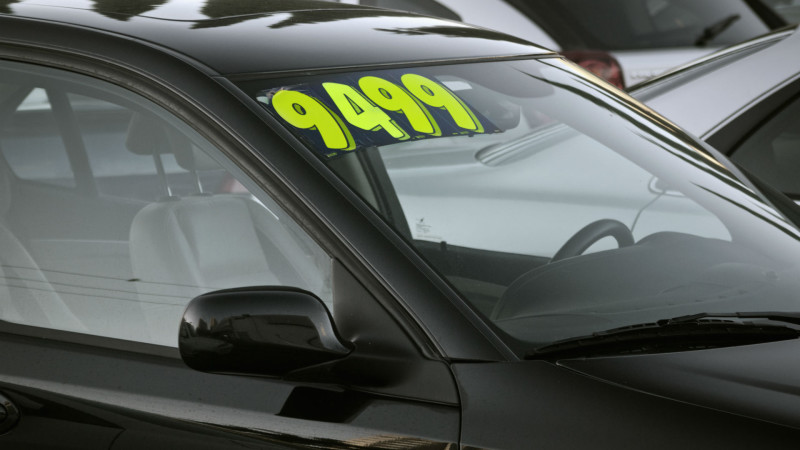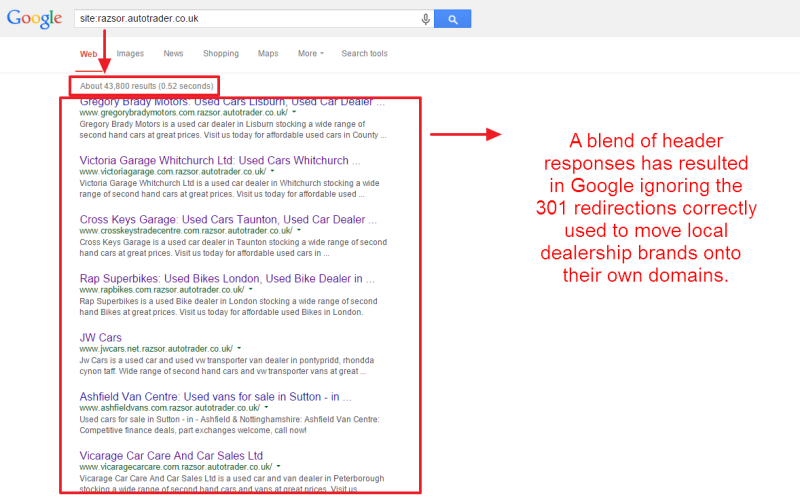
Sites around second-hand car sales tend to be heavily invested in online. However, due to tired legacy e-commerce platforms and challenging listing issues, sometimes their SEO problems can add up to massive traffic and conversion headaches.
Today, I’ll take a walk though some of the more painful issues for site architecture and their solutions.
Local Dealerships Indexing Woe
Let’s start with a quick look the UK’s largest second-hand car listing site: Autotrader.
With 3.6 million indexed Google listings, you’d expect every car type possible in their inventory — and you wouldn’t be far off! But when you kick the tires (sorry!) on their local dealership subdomain, razsor.autotrader.co.uk, you’ll find a confusing blend of 200 Page OK header responses, 301 redirects, and 302 redirects.
The upshot is that these pages should all be 301 redirecting to local dealership sites, but this is not happening consistently. As a result, Google is failing to follow the 301s that are implemented correctly, and this is causing pages on the subdomain to be indexed (when really, the local dealership site should be the only version indexed).

Not all of these URLs consistently 301 and so are kept in Google’s index.
That’s an issue that can cause Google to start ignoring new URLs on the main domain, delaying indexing for new cars coming online, reducing their visibility, and causing them to lose first indexing content buffs in Google.
In essence, the cause of the issue are the 302s and the 301s pointing to largely identical pages on different domains. Google is tentative about following 301s to different domains at the best of times — and unless you are doing a full domain switch with Webmaster verification of both domains and comprehensive 301 rules for all migrated URLs, you’ll find Google holding old URLs for periods of months rather than days.
302s in particular suffer from the hangover of the old days of 302 hijacking and are very slow to be accepted as a redirect. This can seriously affect indexing — though they will indeed come to be seen as equivalent to a 301, that can often take a very long time!
This is a simple issue, with significant impact if left unchecked. There isn’t a quick fix, but consistent 301s will dramatically speed up the process of migrating away dealership pages to their new domain homes.
Stock Control, Canonicals 302s Oh My!
One of Autotrader’s competitors in the UK, Exchange and Mart, has a listing control issue that’s also informative and has a significant commercial impact.
All second-hand car listings will run out of stock regularly — and when things go wrong here, they go very wrong. Though they boast a similar index size to Autotrader, EM doesn’t stock the same volume of cars — so why the discrepancy?
In short: 302s are killing EMs ability to retain SEO value and keep its indexing numbers trim.
When a car is listed on the site, it is given its own URL, which contains a unique identifier in the URL string. Once that car is purchased (and therefore no longer available), its listing URL should ideally 301 redirect to another page.
What’s happening instead is that the URL is 302 redirecting to a category page and appending a URL parameter “notfound,†along with the car’s unique ID (even worse!). Because it’s a 302, these URLs stay in Google’s index for a long time.

The URL highlighted in the screenshot above (from Google’s cache) 302 redirects to a the following URL:
Ideally, it would just 301 redirect to http://www.exchangeandmart.co.uk/used-cars-for-sale/vauxhall/tigra.
When looking at these “notfound†URLs in Google, there are only a few in the index (out of hundreds of thousands of car pages to which this effect has been applied over the years!).
These index numbers are kept down by the use of an un-parametered canonical tag on these brand pages, which will be treated as equivalent to a 301 by Google. That is, however, effectively a redirect chain — 302 to 301 — that’s required to be followed before value is passed on. That’s not happening well because of the 302 being incorrectly used (replace this with a 301) and the passing of value to a parametered URL that then tries to canonicalize.
When you look at the total listings held on EM, we should only be seeing around 250,000 total URLs in Google’s index. Instead, we have over three million more!
Just as with the Autotrader issue, this will also have a debilitating effect on EM’s ability to get new listings indexed quickly, which affects their ability to capture organic traffic via SEO (and there are a number of other pretty profound SEO issues there already), and sell advertising on the EM pages.
Changing the sold car behavior to issue a straight 301 to an unparametered URL would solve this issue immediately and drive significant impact for their SEO. Rankings generally would improve as domain value is spread over fewer indexed pages. I’d expect to see those sold car URLs drop out pretty quickly with this change. New car listings would also get indexed more quickly and perform better for search terms relating to the car type — highly important for gaining higher bid numbers for their business to further attract sellers to their platform.
It goes to show that when it comes to getting a good deal on your used car(‘s website SEO), it pays to shop around.
Some opinions expressed in this article may be those of a guest author and not necessarily Search Engine Land. Staff authors are listed here.
Be a part of the world’s largest search marketing conference, Search Engine Land’s SMX East. The robust agenda covers the latest tactics in paid search, SEO, mobile, analytics and more. Register today and save $300, or come as a team and save 10%-20%.
About The Author
(Some images used under license from Shutterstock.com.)
Article source: http://searchengineland.com/used-car-sales-seo-two-tales-woe-221904
